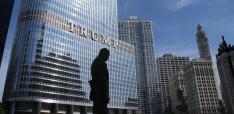Will The Young Save America?

GP Columnist Scott L. Montgomery argues that young people have an opportunity to play the leading role in reverting the USA’s democratic backslide.
It seems time that two vital truths be brought together. The first is this: young people are more likely to be the solution for America’s political social and political than their elders. There are many reasons for this, but one of the most important is that people under 30 are no longer apathetic or cynical about politics; on the contrary. In large numbers, they have become more engaged than ever before, and though they still remain the lowest voting group of any age, their participation has been rising rapidly, especially for Democrats. Here, then, would seem to be an opportunity.
Compared to those who have committed themselves to a disastrous present, young people are far more invested in a future for functional democracy. They are more inclined to accept modern science, the looming threat of climate change, the value of vaccines, the folly of “alternate facts,” the appalling legacies of racism, the need for serious political reform, and, not least, the absolute necessity to reorient the country away from ever-more violent and threatening actions that have darkened a new century already swollen with planetary challenges. In a word, America, land of youthfulness, needs the young for more than evidence of beauty, ambition, and self-concern.
A key fact to consider: people 18-35 now comprise the largest population—some 83 million—now eligible to vote. By the end of this decade, another 34 million will have turned 18. If birth rates continue to fall or remain as low as they now are (1.6 births per woman, well below the 2.1replacement level), those under-35 will comprise the largest cohort of potential voters to mid-century 2050 and even after. No other age group, therefore, is more important for turning the country in a new direction.
What, then, about voter turnout rates? The age cohort for young people commonly includes those under 30 (18-29), with older groups at 30-44, 45-59, and 60+. Data along these lines shows higher turnout with age: those over 60 with rates varying from 65% to 72% for presidential elections, 55% - 70% for midterms, while the 45-59 age group has similar rates for presidential and 45%-55% for midterm elections. Those aged 30-44 come in at about 10% lower than the 45-59 group. Under-30s exhibit a unique trend: for presidential elections, consistently 32%-42% until 2004, when rates began to rise, as high as 50% in 2008 and 53% in 2020.
These are not trivial or minor changes. Younger voters have become more engaged in the new century, not least because of problems that affect them directly, such as the “forever wars” of Iraq and Afghanistan, the assaults on democratic freedom, the resurgence of overt racism, the growing impacts of climate change, and the aggressive realms of misinformation.
The second truth returns to the U.S. situation itself. Commentators continue to portray America wavering at the edges of an historic crisis. Warning signs seem clarion; last year, 2021, confirmed that its democracy could soon fail if the country does not pull back and shore itself up. Such diagnoses, however, lag the reality. The crisis is here; we inhabitants are the frogs in the pot, watching steam rise from the water’s surface. The Big Lie of a stolen election, the attack on the Capitol, Republican denial of its significance, their re-embrace of Donald Trump—all of this, along with the widespread rejection of masks and vaccines, counts as evidence the U.S. has gone over the cliff.
The GOP has worked very hard, with ferric discipline and strategic audacity, to damage American democracy in their favor. They now find themselves chained to a sizeable minority that inhabits an alternative world of conspiracies and fear of “radical socialism.” But this is not a problem for a majority of Republicans, since so many of them apparently adhere to the same beliefs. They now seek, at the state level, to impose new laws and rules that restrict voting, not least by minorities, employing the democratic process to further destroy democracy itself.
Experts on political violence now talk about what was once called “the unthinkable.” Scenarios for actual domestic war are only too conceivable, in fact. The spark could be a fiercely contested 2022 or 2024 election, unleashing weakly bottled rage on the far right. Based on patterns seen in other democratic states of the past century, the result would be guerilla-type violence of varied form. Attacks like the 1995 Oklahoma City bombing, the 2020 plot to kidnap and execute Michigan’s governor, as well as armed assaults on government and civilian targets describe the pattern. A decadal civil war, as in the neo-Nazi manifesto, Turner Diaries (admired by far-right extremists), meant to create instability and open space for an autocratic leader, could be the plan. A case could even be made, based on the growing scope of domestic terrorism, that something along these lines has already begun or been in preparation.
The massive scale of youth non-voting has been called the “slumbering leviathan” of U.S. democracy. Though somewhat condescending, the label is partly apt in that it suggests the phenomenon will prove temporary. To date, the most successful effort to mobilize younger voters was by the Obama campaign in the 2008 election, which utilized young volunteers to recruit young voters, using venues especially familiar to them at the time (social media). Compared to a 53% showing for Democrats as a whole that year, the under-30 vote went 66% to Obama. Creating a highly committed brigade of youth campaign workers also did good things for Joe Biden in 2020, as the youth vote was key to his victory. One should not discount, however, the reactive dimension involved as well. The collective disasters of the Bush and Trump years played their part to engage young people at a higher level.
Since 2004, in fact, the youth vote has increasingly swung Democrat for both presidential and midterm elections. The midterm year 2018 was especially strong, with 18-29 year-olds voting 67% Democrat and only 32% Republican. For the 2020 presidential election, the numbers were 61% for Biden, 36% for Trump.
These figures are not surprising. Republicans have whittled their message down such that it appeals mainly to anti-abortionists and scared, angry older white voters. The GOP largely sees the youth of today as an enemy—racially and ethnically diverse, pro LBGTQ+ rights, unmoved by the presumed terrors of socialism. Republican efforts to deny and overturn the legitimacy of the 2020 election are attempts to erase the youth vote more than anything else. No less, GOP state laws to restrict voting are squarely aimed at young people as well as people of color. These are facts that Democrats can use assertively to their advantage. That the GOP has largely turned its back on the youth vote opens a considerable field.
It pays to be honest, though. Encouraging a much greater portion of young people to vote and to do so in favor of liberal democratic values will not be quick or easy. Nor can it be done in lukewarm fashion or on the cheap. It will take improved unity, loyalty to cause, sacrifice, money, and, not least, time. Studies offer a number of reasons for lower turnout among the young—confusion about the process; a busy life with no time off; disappointment with candidates. Among these (and others), the first tends to be especially determining. It counts as a real problem that voting has been removed from federal protections and given over to local decisions. Individual states have created an absurd patchwork of different systems and rules. In many cases, the procedure that must be followed from registration to ballot is both cumbersome and unclear. Shortening the time period for registration, restricting mail-in voting, preventing voting on weekends, and tossing out ballots whose signature is not exactly the same as on a registration form, are only a few examples. This has gotten worse for minorities in the wake of recent Supreme Court decisions that weakened the 1965 Voting Rights Act, allowing states to impose more restrictive voter ID laws legislated by GOP-dominated legislatures. But another reason more young people don’t vote, often overlooked, is the limited outreach to contact individuals
It took Republicans an entire generation to succeed in local and national elections as a minority party of extremists. Should Democrats wish to break America’s fall and build democracy back to a better circumstance of stability, they have their opponent’s example to consider. As it has come to exist, the GOP has chosen a dead end. In alienating so many of those under 30, they have estranged themselves from the future.
For Democrats, one helpful idea might be to “grow voters.” This means teaching primary and secondary school students the history and power of the vote, the battles that have been won, lost, and fought again over democracy’s most fundamental right. Programs with this type of approach in mind, like Generation Citizen, already exist in the non-profit sector. They have done much good and could be greatly expanded if included in the party platform.
In general, however, Democrats might consider that young voters are not like those of former decades. They reject apathy, attend to political news, discuss related matters with friends, worry about the country. Surveys indicate many want “to make a difference” on issues they care about—healthcare, gun violence, racism, social justice, climate change. For young women, the availability of abortion is a real concern as well. In the 2020 election, young people strongly rejected the Republican agenda. This doesn’t necessarily mean they favored progressive positions on everything. But they strongly sided with arguments to expand government involvement in infrastructure, public health, affordable education, housing, and climate-related programs.
Young Americans understand that deep change must happen for the country to revitalize its commitment to values of equality, tolerance, and openness. As the largest cohort of eligible voters in U.S. history, they lean more left than right by a wide and growing margin. There are no certainties in this, to be sure. Yet, should the urges to violence be kept at bay, America might once again find a way out of an era of self-created darkness.
Scott L. Montgomery is an author, geoscientist, and affiliate faculty member in the Jackson School of International Studies, University of Washington, Seattle. He has 25 years' experience in the energy industry, where he worked on projects in many parts of the world. His many technical publications include papers, monographs, articles, and textbooks, mainly focused on cutting edge hydrocarbon plays, technologies, related impacts and issues.
The views in this post do not represent GP or any of its parent organisations and are the author's own.
Photo by Afta Putta Gunawan from Pexels


